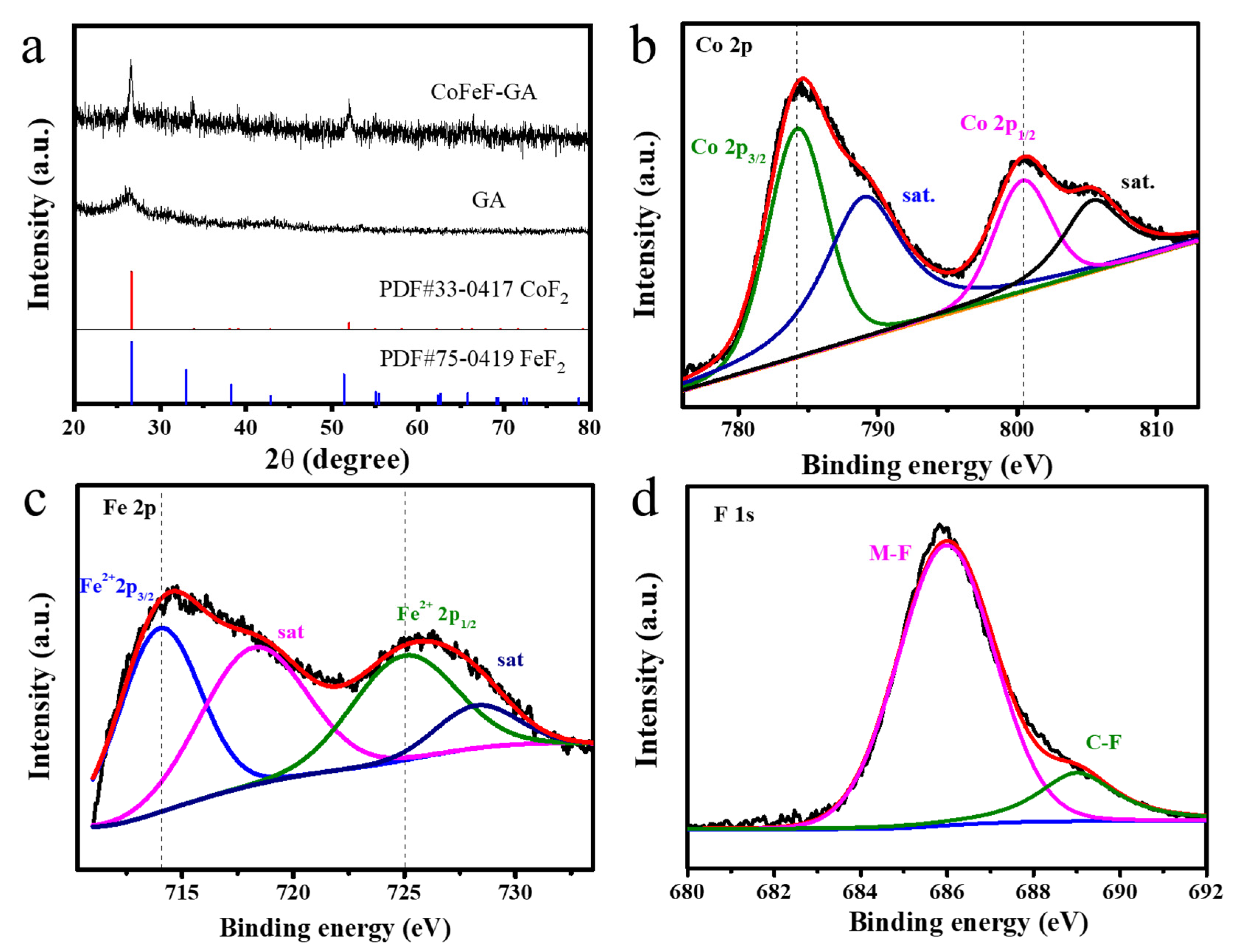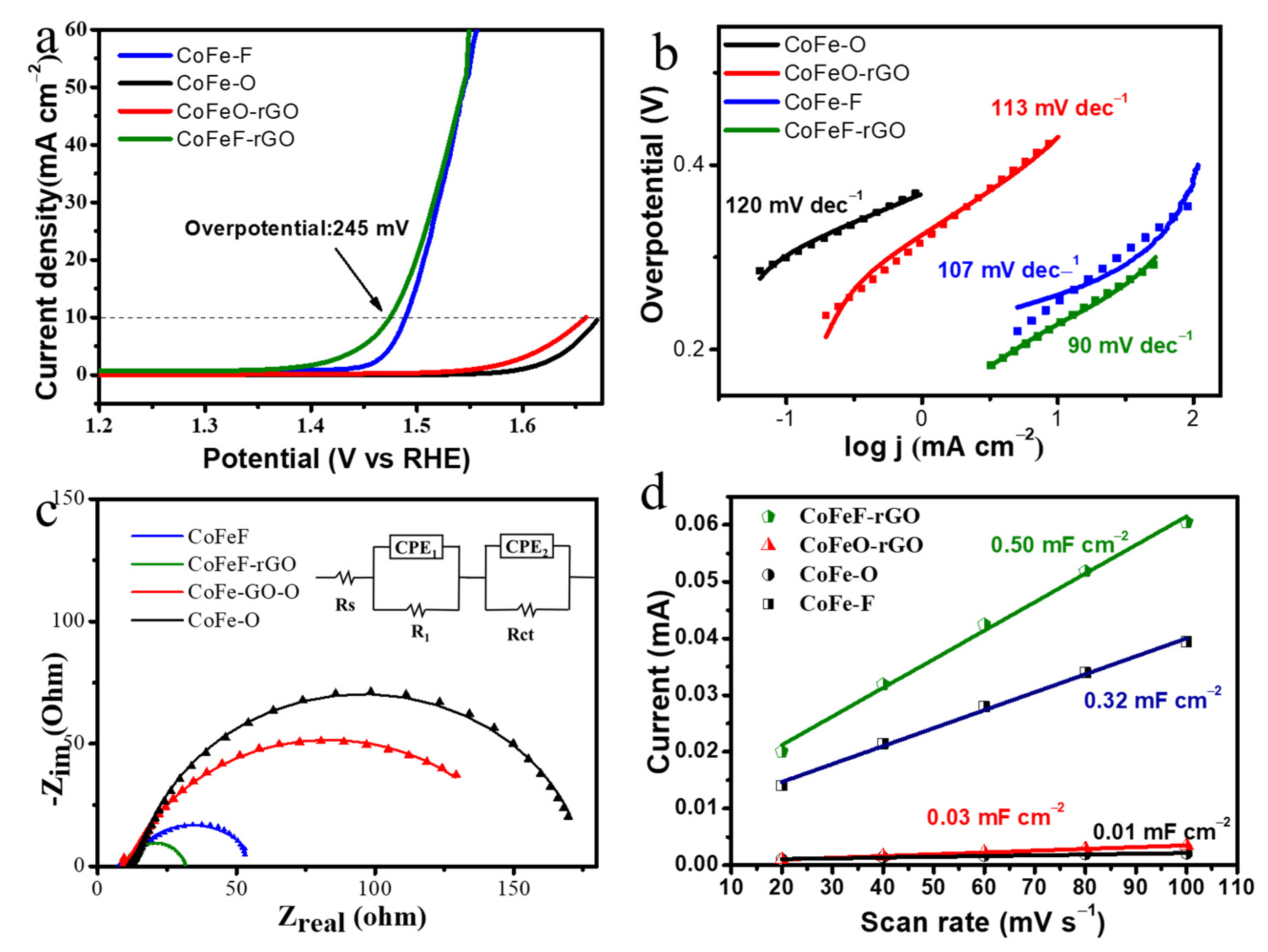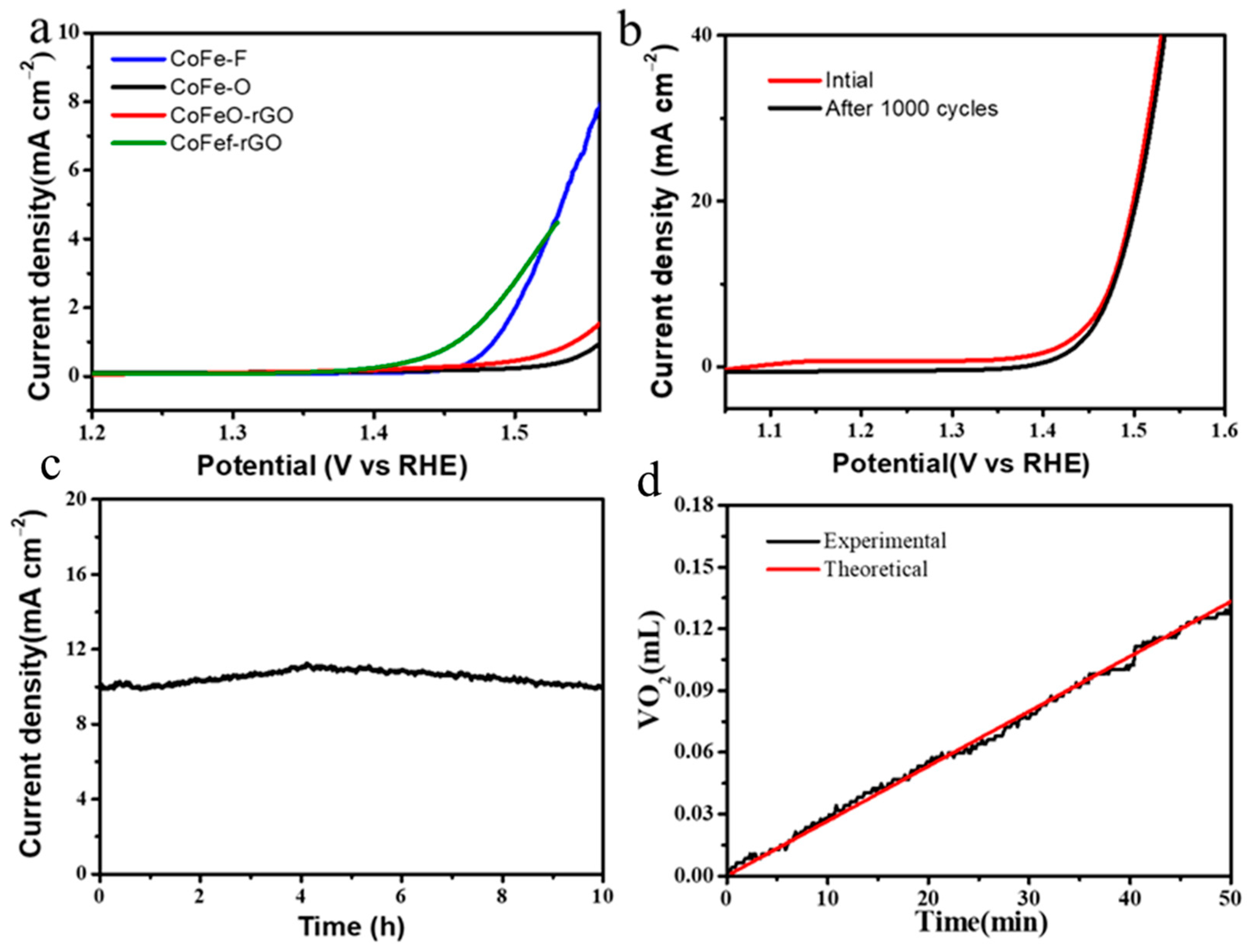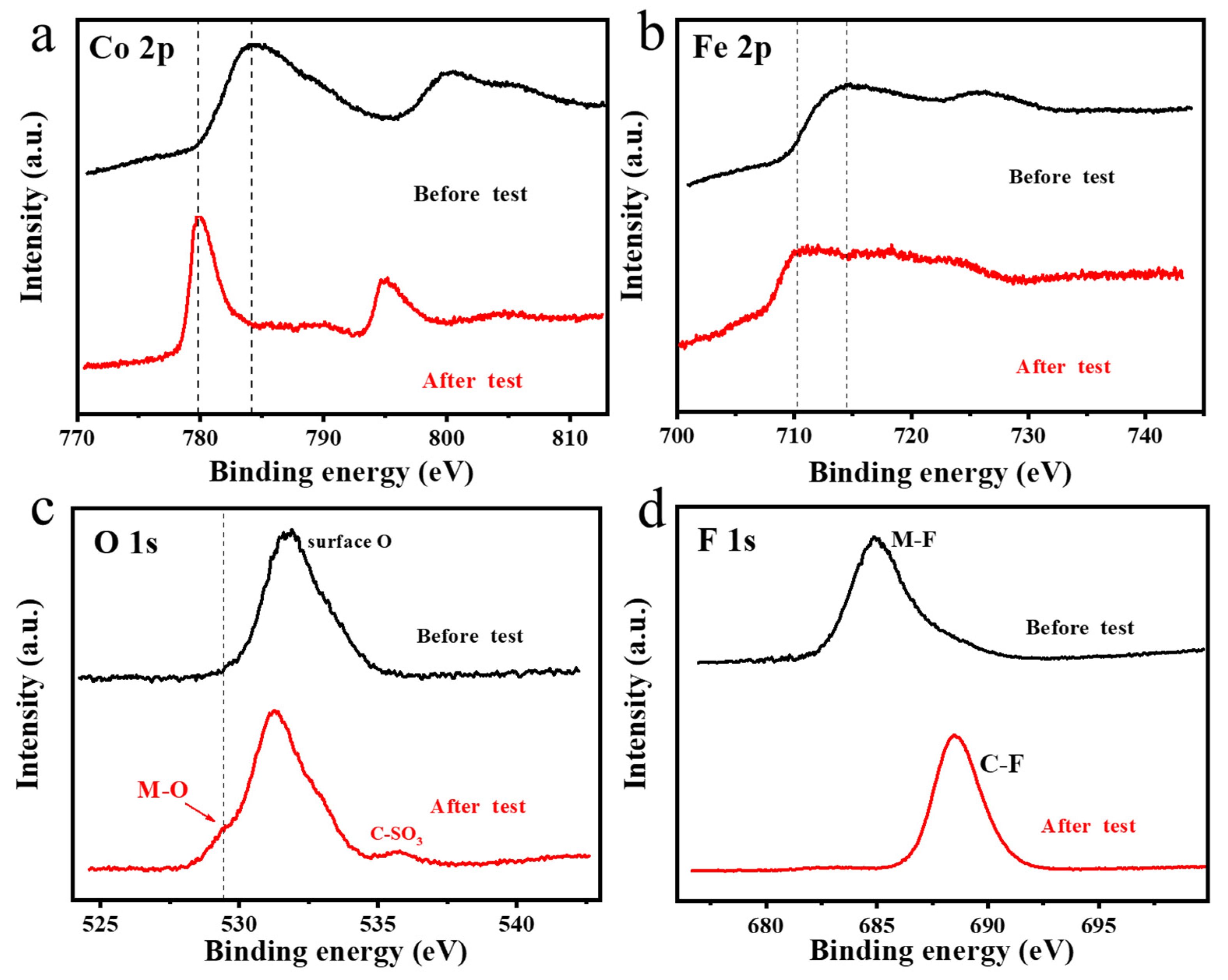Graphene Architecture-Supported Porous Cobalt–Iron Fluoride Nanosheets for Promoting the Oxygen Evolution Reaction
Abstract
:1. Introduction
2. Materials and Methods
2.1. Chemicals
2.2. Synthesis of CoFeF
2.3. Synthesis of CoFeF-GA
2.4. Characterizations
2.5. Electrochemical Measurements
3. Results
3.1. The Morphological Structure of CoFeF-GA
3.2. Electrochemical Performance
4. Conclusions
Supplementary Materials
Author Contributions
Funding
Data Availability Statement
Acknowledgments
Conflicts of Interest
References
- Song, H.; Yu, J.; Tang, Z.; Yang, B.; Lu, S. Halogen-Doped Carbon Dots on Amorphous Cobalt Phosphide as Robust Electrocatalysts for Overall Water Splitting. Adv. Energy Mater. 2022, 12, 2102573. [Google Scholar] [CrossRef]
- Song, H.; Wu, M.; Tang, Z.; Tse, J.S.; Yang, B.; Lu, S. Single Atom Ruthenium-Doped CoP/CDs Nanosheets via Splicing of Carbon-Dots for Robust Hydrogen Production. Angew Chem. Int. Edit. 2021, 60, 7234–7244. [Google Scholar] [CrossRef]
- Wu, Y.J.; Yang, J.; Tu, T.X.; Li, W.Q.; Zhang, P.F.; Zhou, Y.; Li, J.F.; Li, J.T.; Sun, S.G. Evolution of Cationic Vacancy Defects: A Motif for Surface Restructuration of OER Precatalyst. Angew Chem. Int. Edit. 2021, 60, 26829–26836. [Google Scholar] [CrossRef]
- Yang, W.; Zhang, Q.; Siwal, S.S.; Hua, Y.; Xu, C. Dynamic structure evolution of free-standing S-doped porous Co-Fe microspheres with enhanced oxygen evolution electrocatalysis in alkaline media. Electrochim. Acta 2020, 361, 137038. [Google Scholar] [CrossRef]
- Yu, X.; Zhao, Z.; Pei, C. Surface oxidized iron-nickel nanorods anchoring on graphene architectures for oxygen evolution reaction. Chinese Chem. Lett. 2021, 32, 3579–3583. [Google Scholar] [CrossRef]
- Zhai, Z.; Li, H.; Zhou, C.-a.; Zheng, H.; Liu, Y.; Yan, W.; Zhang, J. Anisotropic Strain Boosted Hydrogen Evolution Reaction Activity of F-NiCoMo LDH for Overall Water Splitting. J. Electrochem. Soc. 2023, 170, 036509. [Google Scholar] [CrossRef]
- Li, M.; Liu, H.; Feng, L. Fluoridation-induced high-performance catalysts for the oxygen evolution reaction: A mini review. Electrochem. Commun. 2021, 122, 106901. [Google Scholar] [CrossRef]
- Li, X.-P.; Huang, C.; Han, W.-K.; Ouyang, T.; Liu, Z.-Q. Transition metal-based electrocatalysts for overall water splitting. Chin. Chem. Lett. 2021, 32, 2597–2616. [Google Scholar] [CrossRef]
- Zheng, D.; Jing, Z.; Zhao, Q.; Kim, Y.; Li, P.; Xu, H.; Li, Z.; Lin, J. Efficient Co-doped pyrrhotite Fe0.95S1.05 nanoplates for electrochemical water splitting. Chem. Eng. J. 2020, 402, 125069. [Google Scholar] [CrossRef]
- Li, D.; Liu, C.; Ma, W.; Xu, S.; Lu, Y.; Wei, W.; Zhu, J.; Jiang, D. Fe-doped NiCoP/Prussian blue analog hollow nanocubes as an efficient electrocatalyst for oxygen evolution reaction. Electrochim. Acta 2020, 367, 137492. [Google Scholar] [CrossRef]
- Lu, L.; Zhang, Y.; Chen, Z.; Feng, F.; Teng, K.; Zhang, S.; Zhuang, J.; An, Q. Synergistic promotion of HER and OER by alloying ternary Zn-Co-Ni nanoparticles in N-doped carbon interfacial structures. Chin. J. Catal 2022, 43, 1316–1323. [Google Scholar] [CrossRef]
- Zha, M.; Pei, C.; Wang, Q.; Hu, G.; Feng, L. Electrochemical oxygen evolution reaction efficiently boosted by selective fluoridation of FeNi3 alloy/oxide hybrid. J. Energy Chem. 2020, 47, 166–171. [Google Scholar] [CrossRef]
- Wang, Y.; Jiang, Y.; Zhao, Y.; Ge, X.; Lu, Q.; Zhang, T.; Xie, D.; Li, M.; Bu, Y. Design strategies of perovskite nanofibers electrocatalysts for water splitting: A mini review. Chem. Eng. J. 2023, 451, 138710. [Google Scholar] [CrossRef]
- Cui, M.; Yang, C.; Li, B.; Dong, Q.; Wu, M.; Hwang, S.; Xie, H.; Wang, X.; Wang, G.; Hu, L. High-Entropy Metal Sulfide Nanoparticles Promise High-Performance Oxygen Evolution Reaction. Adv. Energy Mater. 2021, 11, 2002887. [Google Scholar] [CrossRef]
- Wang, M.; Zhang, L.; He, Y.; Zhu, H. Recent advances in transition-metal-sulfide-based bifunctional electrocatalysts for overall water splitting. J. Mater. Chem. A 2021, 9, 5320–5363. [Google Scholar] [CrossRef]
- Peng, Q.; He, Q.; Hu, Y.; Isimjan, T.T.; Hou, R.; Yang, X. Interface engineering of porous Fe2P-WO2.92 catalyst with oxygen vacancies for highly active and stable large-current oxygen evolution and overall water splitting. J. Energy Chem. 2022, 65, 574–582. [Google Scholar] [CrossRef]
- Feng, X.; Jiao, Q.; Dai, Z.; Dang, Y.; Suib, S.L.; Zhang, J.; Zhao, Y.; Li, H.; Feng, C.; Li, A. Revealing the effect of interfacial electron transfer in heterostructured Co9S8@NiFe LDH for enhanced electrocatalytic oxygen evolution. J. Mater. Chem. A 2021, 9, 12244–12254. [Google Scholar] [CrossRef]
- Jiang, J.; Xu, J.; Wang, W.; Zhang, L.; Xu, G. Phosphate Ion-Functionalized CoS with Hexagonal Bipyramid Structures from a Metal–Organic Framework: Bifunctionality towards Supercapacitors and Oxygen Evolution Reaction. Chem. Eur. J 2020, 26, 14903–14911. [Google Scholar] [CrossRef]
- Hu, J.; Li, Z.; Zhao, D.; Han, Z.; Wu, X.; Zhai, J.; Liu, Z.; Tang, Y.; Fu, G. l-Lysine-induced green synthesis of CoS/Co3O4 nanoframes for efficient electrocatalytic oxygen evolution. Green Chem. 2023, 25, 7309–7317. [Google Scholar] [CrossRef]
- Wang, Z.; Li, B.; Wang, L.; Chu, L.; Yang, M.; Wang, G. Amorphous-crystalline coupling CoS/NixPy/Fe-Ni3S2 heterostructure nanoplate array on NF for efficient overall water splitting. Electrochim. Acta 2023, 462, 142767. [Google Scholar] [CrossRef]
- Pei, C.; Gu, Y.; Liu, Z.; Yu, X.; Feng, L. Fluoridated Iron–Nickel Layered Double Hydroxide for Enhanced Performance in the Oxygen Evolution Reaction. ChemSusChem 2019, 12, 3849–3855. [Google Scholar] [CrossRef]
- Pei, C.; Chen, H.; Dong, B.; Yu, X.; Feng, L. Electrochemical oxygen evolution reaction efficiently catalyzed by a novel porous iron-cobalt-fluoride nanocube easily derived from 3-dimensional Prussian blue analogue. J. Power Sources 2019, 424, 131–137. [Google Scholar] [CrossRef]
- Niyitanga, T.; Kim, H. Bimetallic-based CuxCo3−xO4 nanoparticle-embedded N-doped reduced graphene oxide toward efficient oxygen evolution reaction and hydrogen evolution reaction for bifunctional catalysis. J. Power Sources 2023, 580, 233383. [Google Scholar] [CrossRef]
- Yu, R.; Wang, C.; Liu, D.; Wang, X.; Yin, J.; Du, Y. Self-Reconstruction of Fe-Doped Co-Metal–Organic Frameworks Boosted Electrocatalytic Performance for Oxygen Evolution Reaction. Inorg. Chem. 2023, 62, 609–617. [Google Scholar] [CrossRef]
- Yang, P.; Jiang, Z.; Shi, Y.; Ren, X.; Liang, L.; Shao, Q.; Zhu, K. Enhancement of oxygen evolution reaction performance of FeCoNiCrMn high entropy alloy thin film electrodes through in-situ reconstruction. J. Alloys Compd. 2023, 947, 169699. [Google Scholar] [CrossRef]
- Srinivas, K.; Ma, F.; Liu, Y.; Zhang, Z.; Wu, Y.; Chen, Y. Metal–Organic Framework-Derived Fe-Doped Ni3Se4/NiSe2 Heterostructure-Embedded Mesoporous Tubes for Boosting Oxygen Evolution Reaction. ACS Appl. Mater. Interfaces 2022, 14, 52927–52939. [Google Scholar] [CrossRef]
- Yuan, N.N.; Jiang, Q.Q.; Li, J.; Tang, J.G. A review on non-noble metal based electrocatalysis for the oxygen evolution reaction. Arab. J. Chem. 2020, 13, 4294–4309. [Google Scholar] [CrossRef]
- Chen, H.-X.; Xu, H.; Song, Z.-R.; Liu, Y.; Cui, H.; Gao, J.-K. Pressure-induced bimetallic carbon nanotubes from metal–organic frameworks as optimized bifunctional electrocatalysts for water splitting. Rare Metals 2023, 42, 155–164. [Google Scholar] [CrossRef]
- Suragtkhuu, S.; Bat-Erdene, M.; Bati, A.S.R.; Shapter, J.G.; Davaasambuu, S.; Batmunkh, M. Few-layer black phosphorus and boron-doped graphene based heteroelectrocatalyst for enhanced hydrogen evolution. J. Mater. Chem. A 2020, 8, 20446–20452. [Google Scholar] [CrossRef]
- Duan, J.-J.; Zhang, R.-L.; Feng, J.-J.; Zhang, L.; Zhang, Q.-L.; Wang, A.-J. Facile synthesis of nanoflower-like phosphorus-doped Ni3S2/CoFe2O4 arrays on nickel foam as a superior electrocatalyst for efficient oxygen evolution reaction. J. Colloid. Interf. Sci. 2021, 581, 774–782. [Google Scholar] [CrossRef]
- Chen, L.-F.; Hou, C.-C.; Zou, L.; Kitta, M.; Xu, Q. Uniformly bimetal-decorated holey carbon nanorods derived from metal−organic framework for efficient hydrogen evolution. Sci. Bull. 2021, 66, 170–178. [Google Scholar] [CrossRef] [PubMed]
- Yuan, Y.; Rong, J.; Zheng, L.; Hu, Z.; Hu, S.; Wu, C.; Zhuang, Z. Control of the metal-support interactions in Ru on N-doped graphene-encapsulated Ni nanoparticles to promote their hydrogen evolution reaction catalytic performance. Int. J. Hydrogen Energy 2023, 6, 124. [Google Scholar] [CrossRef]
- Lim, H.; Lee, B.; Yun, D.; Al Munsur, A.Z.; Chae, J.E.; Lee, S.Y.; Kim, H.J.; Nam, S.Y.; Park, C.H.; Kim, T.H. Poly(2,6-dirnethyl-1,4-phenylene oxide)s with Various Head Groups: Effect of Head Groups on the Properties of Anion Exchange Membranes. ACS Appl. Mater. Interfaces 2018, 10, 41279–41292. [Google Scholar] [CrossRef] [PubMed]
- Chen, X.; Liu, Y.; Gao, W.; Yang, G.; Qureshi, A.H.; Chen, M.; Yao, X.; Zhou, M.; Zhang, X.; Liu, Y. High Electrocatalytic Activity of Defected MX2/Graphene Heterostructures (M = Mo, W.; X = S, Se) for Hydrogen Evolution Reaction. J. Phys. Chem. C 2021, 125, 15292–15300. [Google Scholar] [CrossRef]
- Xue, Y.; Wang, Y.; Liu, H.; Yu, X.; Xue, H.; Feng, L. Electrochemical oxygen evolution reaction catalyzed by a novel nickel–cobalt-fluoride catalyst. Chem. Commun. 2018, 54, 6204–6207. [Google Scholar] [CrossRef]
- Lin, Z.; Wang, C.; Wang, Z.; Liu, Q.; Le, C.; Lin, B.; Chen, S. The role of conductivity and phase structure in enhancing catalytic activity of CoSe for hydrogen evolution reaction. Electrochim. Acta 2019, 294, 142–147. [Google Scholar] [CrossRef]
- Li, M.; Gu, Y.; Chang, Y.; Gu, X.; Tian, J.; Wu, X.; Feng, L. Iron doped cobalt fluoride derived from CoFe layered double hydroxide for efficient oxygen evolution reaction. Chem. Eng. J. 2021, 425, 130686. [Google Scholar] [CrossRef]
- Zhang, G.; Li, Y.; Xiao, X.; Shan, Y.; Bai, Y.; Xue, H.-G.; Pang, H.; Tian, Z.; Xu, Q. In Situ Anchoring Polymetallic Phosphide Nanoparticles within Porous Prussian Blue Analogue Nanocages for Boosting Oxygen Evolution Catalysis. Nano Lett. 2021, 21, 3016–3025. [Google Scholar] [CrossRef]
- Wang, B.; Chen, Y.; Wang, X.; Ramkumar, J.; Zhang, X.; Yu, B.; Yang, D.; Karpuraranjith, M.; Zhang, W. rGO wrapped trimetallic sulfide nanowires as an efficient bifunctional catalyst for electrocatalytic oxygen evolution and photocatalytic organic degradation. J. Mater. Chem. A 2020, 8, 13558–13571. [Google Scholar] [CrossRef]
- Wang, T.; Xu, W.; Wang, H. Ternary NiCoFe Layered Double Hydroxide Nanosheets Synthesized by Cation Exchange Reaction for Oxygen Evolution Reaction. Electrochim. Acta. 2017, 257, 118–127. [Google Scholar] [CrossRef]
- Li, W.; Murisana, A.; Zhang, Q.; Wang, S.; De, G. Controlled synthesis and M-position regulation of perovskite fluoride KMF3 (M=Co/Fe) with high-efficiency OER performance. Electrochem. Commun. 2022, 141, 107363. [Google Scholar] [CrossRef]
- Wang, G.; Cao, W.; Zhang, Z.; Liu, L.; Wang, C.; Yin, J.; Zhou, H. Ternary sulfide nanoparticles anchored in carbon bubble structure for oxygen evolution reaction. J. Alloys Compd. 2023, 968, 172314. [Google Scholar] [CrossRef]
- Wang, J.; Zeng, H.C. Hybrid OER Electrocatalyst Combining Mesoporous Hollow Spheres of N, P-Doped Carbon with Ultrafine Co2NiOx. ACS Appl. Mater. Interfaces. 2020, 12, 50324–50332. [Google Scholar] [CrossRef] [PubMed]
- Xue, J.; Liu, Z.; Fan, Y.; Wang, R.; Li, Y. ZIF-derived Fe,Co coordinated N/O-codoped three-dimensional tungsten–carbon matrix for the performance-enhanced zinc-air flow battery and water splitting. Chem. Eng. J. 2023, 476, 146502. [Google Scholar] [CrossRef]
- Kim, D.; Jeong, Y.; Roh, H.; Lim, C.; Yong, K. Biomimetic 2D-Ni(Co,Fe)P/1D-WOx nanocoral reef electrocatalysts for efficient water splitting. J. Mater. Chem. A. 2021, 9, 10909–10920. [Google Scholar] [CrossRef]
- Li, Z.; Zhang, L.; Zhu, Q.; Ke, Z.; Hu, G. Spatial separation strategy to construct N/S co-doped carbon nanobox embedded with asymmetrically coupled Fe-Co pair-site for boosted reversible oxygen electrocatalysis. J. Colloid Interface Sci. 2024, 653, 1577–1587. [Google Scholar] [CrossRef] [PubMed]
- Jiang, T.; Dai, P.; Zhang, W.; Wu, M. Fish bone-derived N, S co-doped interconnected carbon nanofibers network coupled with (Fe, Co, Ni)9S8 nanoparticles as efficient bifunctional electrocatalysts for rechargeable and flexible all-solid-state Zn-air battery. Electrochim. Acta. 2021, 373, 137903. [Google Scholar] [CrossRef]
- Zhang, Y.; Wang, P.; Yang, J.; Li, K.; Zhang, N.; Liu, G.; Duan, Y.; Qiu, J. Mechanochemical coordination self-assembly for Cobalt-based metal-organic framework-derived bifunctional oxygen electrocatalysts. J. Colloid Interface Sci. 2022, 613, 733–746. [Google Scholar] [CrossRef]
- Qin, Y.; Wang, F.; Shang, J.; Iqbal, M.; Han, A.; Sun, X.; Xu, H.; Liu, J. Ternary NiCoFe-layered double hydroxide hollow polyhedrons as highly efficient electrocatalysts for oxygen evolution reaction. J. Energy Chem. 2020, 43, 104–107. [Google Scholar] [CrossRef]
- Jiu, H.; Wei, H.; Wang, C.; Che, S.; Guo, Z.; Han, Y.; Xu, Q.; Yu, X.; Zhang, L. Construction of Co(OH)F/Ni(OH)2@Fe(OH)3 core-shell heterojunction on nickel foam for efficient oxygen evolution. Int. J. Hydrogen Energy. 2022, 47, 33719–33727. [Google Scholar] [CrossRef]





Disclaimer/Publisher’s Note: The statements, opinions and data contained in all publications are solely those of the individual author(s) and contributor(s) and not of MDPI and/or the editor(s). MDPI and/or the editor(s) disclaim responsibility for any injury to people or property resulting from any ideas, methods, instructions or products referred to in the content. |
© 2023 by the authors. Licensee MDPI, Basel, Switzerland. This article is an open access article distributed under the terms and conditions of the Creative Commons Attribution (CC BY) license (https://creativecommons.org/licenses/by/4.0/).
Share and Cite
Lu, Y.; Han, X.; Zhang, Y.; Yu, X. Graphene Architecture-Supported Porous Cobalt–Iron Fluoride Nanosheets for Promoting the Oxygen Evolution Reaction. Nanomaterials 2024, 14, 16. https://doi.org/10.3390/nano14010016
Lu Y, Han X, Zhang Y, Yu X. Graphene Architecture-Supported Porous Cobalt–Iron Fluoride Nanosheets for Promoting the Oxygen Evolution Reaction. Nanomaterials. 2024; 14(1):16. https://doi.org/10.3390/nano14010016
Chicago/Turabian StyleLu, Yanhui, Xu Han, Yiting Zhang, and Xu Yu. 2024. "Graphene Architecture-Supported Porous Cobalt–Iron Fluoride Nanosheets for Promoting the Oxygen Evolution Reaction" Nanomaterials 14, no. 1: 16. https://doi.org/10.3390/nano14010016
APA StyleLu, Y., Han, X., Zhang, Y., & Yu, X. (2024). Graphene Architecture-Supported Porous Cobalt–Iron Fluoride Nanosheets for Promoting the Oxygen Evolution Reaction. Nanomaterials, 14(1), 16. https://doi.org/10.3390/nano14010016





